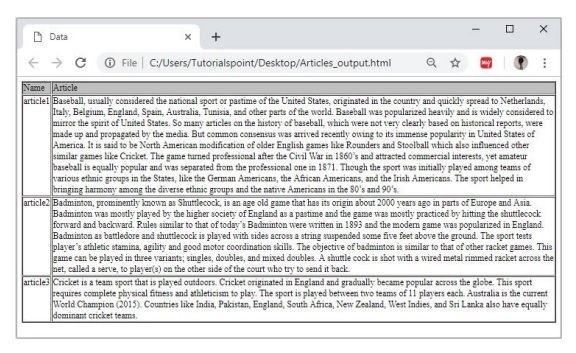How can we insert/store files into MySQL database using JDBC?
Generally speaking, the contents of files are stored in the MySQL database under the Clob (TINYTEXT, TEXT, MEDIUMTEXT, LONGTEXT) data type.
JDBC provides support for the Clob data type, which stores the contents of the file into a database table.
PreparedStatementThe setCharacterStream() method of the interface accepts an integer representing the index of the parameter and a Reader object as parameters.
And sets the contents of the given reader object (file) to the value of the parameter (placeholder) at the specified index.
You can use this method whenever you need to send very large text values.
Use JDBC to store text files:
If you need to store files in the database using the JDBC program to create a table with Clob (TINYTEXT, TEXT, MEDIUMTEXT, LONGTEXT) data type, as follows As shown:
CREATE TABLE Articles(Name VARCHAR(255), Article LONGTEXT);
Now, use JDBC to connect to the database and prepare a PreparedStatement Insert the value into the table created above:
String query = "INSERT INTO Tutorial(Name, Article) VALUES (?,?)";PreparedStatement pstmt = con.prepareStatement(query);
Use the setter method of the PreparedStatement interface Set the value of the placeholder and use the setCharacterStream() method to set the value of the Clob data type.
Example
The following is an example demonstrating how to insert a file Use JDBC program to connect to MySQL database. Here, we have created a table with Clob data type and inserted values in it.
import java.io.FileReader;
import java.sql.Connection;
import java.sql.DriverManager;
import java.sql.PreparedStatement;
public class InsertingFileToDatabase {
public static void main(String args[]) throws Exception {
//Registering the Driver
DriverManager.registerDriver(new com.mysql.jdbc.Driver());
//Getting the connection
String mysqlUrl = "jdbc:mysql://localhost/sampleDB";
Connection con = DriverManager.getConnection(mysqlUrl, "root", "password");
System.out.println("Connection established......");
//Inserting values
String query = "INSERT INTO Articles(Name, Article) VALUES (?, ?)";
PreparedStatement pstmt = con.prepareStatement(query);
pstmt.setString(1, "article1");
FileReader reader = new FileReader("E:\data\article1.txt");
pstmt.setCharacterStream(2, reader);
pstmt.execute();
pstmt.setString(1, "article2");
reader = new FileReader("E:\data\article2.txt");
pstmt.setCharacterStream(2, reader);
pstmt.execute();
pstmt.setString(1, "article3");
reader = new FileReader("E:\data\article3.txt");
pstmt.setCharacterStream(2, reader);
pstmt.execute();
System.out.println("Data inserted......");
}
}Output
Connection established...... Data inserted......
Using MySQL Workbench, you can export the contents of a table to various files, such as html files, .csv files, text files, etc. If you export the contents of a table after inserting data into an HTML file, its output will look like this:

The above is the detailed content of How can we insert/store files into MySQL database using JDBC?. For more information, please follow other related articles on the PHP Chinese website!

Hot AI Tools

Undresser.AI Undress
AI-powered app for creating realistic nude photos

AI Clothes Remover
Online AI tool for removing clothes from photos.

Undress AI Tool
Undress images for free

Clothoff.io
AI clothes remover

AI Hentai Generator
Generate AI Hentai for free.

Hot Article

Hot Tools

Notepad++7.3.1
Easy-to-use and free code editor

SublimeText3 Chinese version
Chinese version, very easy to use

Zend Studio 13.0.1
Powerful PHP integrated development environment

Dreamweaver CS6
Visual web development tools

SublimeText3 Mac version
God-level code editing software (SublimeText3)

Hot Topics
 Reduce the use of MySQL memory in Docker
Mar 04, 2025 pm 03:52 PM
Reduce the use of MySQL memory in Docker
Mar 04, 2025 pm 03:52 PM
This article explores optimizing MySQL memory usage in Docker. It discusses monitoring techniques (Docker stats, Performance Schema, external tools) and configuration strategies. These include Docker memory limits, swapping, and cgroups, alongside
 How to solve the problem of mysql cannot open shared library
Mar 04, 2025 pm 04:01 PM
How to solve the problem of mysql cannot open shared library
Mar 04, 2025 pm 04:01 PM
This article addresses MySQL's "unable to open shared library" error. The issue stems from MySQL's inability to locate necessary shared libraries (.so/.dll files). Solutions involve verifying library installation via the system's package m
 How do you alter a table in MySQL using the ALTER TABLE statement?
Mar 19, 2025 pm 03:51 PM
How do you alter a table in MySQL using the ALTER TABLE statement?
Mar 19, 2025 pm 03:51 PM
The article discusses using MySQL's ALTER TABLE statement to modify tables, including adding/dropping columns, renaming tables/columns, and changing column data types.
 Run MySQl in Linux (with/without podman container with phpmyadmin)
Mar 04, 2025 pm 03:54 PM
Run MySQl in Linux (with/without podman container with phpmyadmin)
Mar 04, 2025 pm 03:54 PM
This article compares installing MySQL on Linux directly versus using Podman containers, with/without phpMyAdmin. It details installation steps for each method, emphasizing Podman's advantages in isolation, portability, and reproducibility, but also
 What is SQLite? Comprehensive overview
Mar 04, 2025 pm 03:55 PM
What is SQLite? Comprehensive overview
Mar 04, 2025 pm 03:55 PM
This article provides a comprehensive overview of SQLite, a self-contained, serverless relational database. It details SQLite's advantages (simplicity, portability, ease of use) and disadvantages (concurrency limitations, scalability challenges). C
 Running multiple MySQL versions on MacOS: A step-by-step guide
Mar 04, 2025 pm 03:49 PM
Running multiple MySQL versions on MacOS: A step-by-step guide
Mar 04, 2025 pm 03:49 PM
This guide demonstrates installing and managing multiple MySQL versions on macOS using Homebrew. It emphasizes using Homebrew to isolate installations, preventing conflicts. The article details installation, starting/stopping services, and best pra
 How do I configure SSL/TLS encryption for MySQL connections?
Mar 18, 2025 pm 12:01 PM
How do I configure SSL/TLS encryption for MySQL connections?
Mar 18, 2025 pm 12:01 PM
Article discusses configuring SSL/TLS encryption for MySQL, including certificate generation and verification. Main issue is using self-signed certificates' security implications.[Character count: 159]
 What are some popular MySQL GUI tools (e.g., MySQL Workbench, phpMyAdmin)?
Mar 21, 2025 pm 06:28 PM
What are some popular MySQL GUI tools (e.g., MySQL Workbench, phpMyAdmin)?
Mar 21, 2025 pm 06:28 PM
Article discusses popular MySQL GUI tools like MySQL Workbench and phpMyAdmin, comparing their features and suitability for beginners and advanced users.[159 characters]






